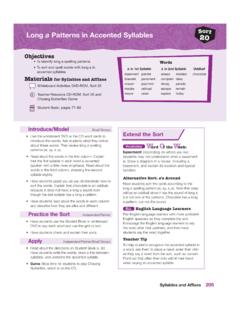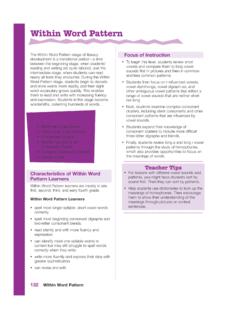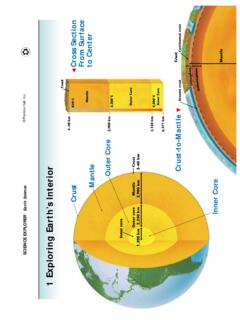Transcription of Dear Family, Expect?: Probability and Expected …
1 Dear Family, The next unit in your child s mathematics class this year is What Do YouExpect?: Probability and Expected value . This unit is about the concepts ofprobability and will help students understand common ideas that they read orhear about every day. They will explore long-range expectations in probabilitysituations and learn how to make better GOALSS tudents will learn to find probabilities in two ways: by conducting trials andcollecting experimental data, also by analyzing situations to determine theoreticalprobabilities. As they work, students will be using fractions, decimals, andpercents to describe how likely events WITH HOMEWORKYou can help with your child s homework and encourage sound mathematicalhabits as your child studies this unit by asking questions such as: What are the possible outcomes that can occur for the events in thissituation? How could I determine the experimental Probability of each of theoutcomes?
2 Is it possible to determine the theoretical Probability of each of theoutcomes? If so, what are these probabilities? How can I use the probabilities I have found to make decisions aboutthis situation? In your child s notebook, you can find worked-out examples from problems done inclass, notes on the mathematics of the unit, and descriptions of the vocabulary CONVERSATIONS ABOUT THE MATHEMATICS IN WHAT DO YOU expect ?You can help your child with his or her work for this unit in several ways: Discuss examples of statements or situations in everyday experiencesthat relate to the likelihood of certain events. For example: What woulda 50% chance of rain mean, and how might forecasters decide on thisfigure? Look at sports statistics with your child and ask questions such as howa batting average or a free-throw average can be used to predict thelikelihood that the player will get a hit the next time at bat or make abasket the next time at the free-throw line.
3 Look over your child s homework and make sure all questions areanswered and that explanations are few important mathematical ideas that your child will learn in What Do YouExpect?are given on the back. As always, if you have any questions or concernsabout this unit or your child s progress in class, please feel free to ,What Do You expect ?2930 What Do You expect ?On the CMP Parent Web Site,you can learn more about the mathematical goals of eachunit, see an illustrated vocabulary list, and examine solutions of selected ACE ConceptsProbability A number between 0 and 1 that describes thelikelihood that an event will Probability If all the outcomesare equally likely, you canfind the theoretical Probability of the eventby first listing all the possible outcomes, thenfind the ratio of the number of outcomes ofinterest to the total number of ProbabilityThis Probability is the relative frequency oftheevent.
4 It is the ratio of the number oftimes the event occurred compared to thetotal number of Events Outcomes that are uncertain when viewedindividually, but which exhibit a predictablepattern over many trials are DiagramThis is a diagram used to determine thenumber of possible outcomes. The number of final branches is equal to the number ofpossible ModelThis is a diagram in which fractions of thearea correspond to probabilities in models are particularly helpful whenthere are 2 events to track and the outcomesof each event are not equally value or Long-term AverageThe average result over many trials is theexpected player s average score per shot in a 1 and 1free throw situation is an Expected value . Aplayer s average winning per lottery ticket isalso an Expected of Large NumbersExperimental data gathered over many trialsshould produce probabilities that are close tothe theoretical probabilities.
5 ExamplesIf a bag contains a red marble, a white marble, and a bluemarble, then the Probability of drawing a red marble is 1 out of 3 or . We would write: P(red) .If a number cube has six sides with the possible outcomes ofrolling: 1, 2, 3, 4, 5, or 6, the Probability of rolling a 3 is 1 out of 6. P(Rolling a 3) If you tossed a coin 50 times and heads occurred 23 times, the relative frequency of heads would be .P(heads) Rolling a fair number cube is random because although youhave no way of knowing what the next roll will be, you doknow that, over the long run, you will roll each number onthe cube about the same number of times. The area model here shows the Probability of getting two red blocksif there are 2 red blocks and 2 blueblocks and one is drawn at a timewithout replacing it. The Probability is or.
6 A game is played with two number cubes. You score 2 pointswhen a sum of 6 is rolled, 1 point for a sum of 3, and 0 pointsfor anything else. If you roll the cubes 36 times, you couldexpect to get a sum of 6 about five times and a sum of 3twice. You could expect to score (5 2) (2 1) 12 points for 36 rolls, an average of point per roll. This is the Expected value of one 1 million flips, exactly 50% heads is improbable, but itwould be extremely unlikely for the percent heads to be verydifferent from 50%.13123616212 First ChoiceRRRB RBRRRB RBBBBR BRBBBBRRBBBBRBBS econd Choice(with red removed)StartheadsFirst CoinSecond CointailsheadstailsheadstailsOutcomehead s-headsheads-tailstails-headstails-tails 2350number of headstotal number of tossesnumber of times the event occurednumber of trials235011there is 1 number 3 on the cube261there are 6 possible outcomes2number of equally likely favorable outcomestotal number of equally likely outcomes1313



















